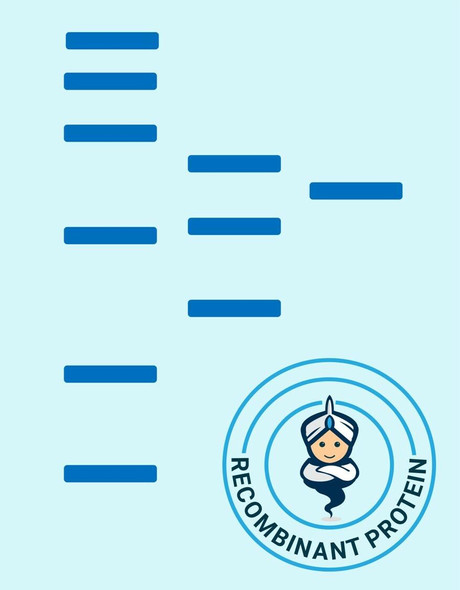Human CLIC2 Recombinant Protein (RPPB3203)
- SKU:
- RPPB3203
- Product type:
- Recombinant Protein
- Size:
- 20ug
- Species:
- Human
- Target:
- CLIC2
- Synonyms:
- Chloride intracellular channel protein 2
- XAP121
- CLIC2
- CLIC2b
- Source:
- Escherichia Coli
- Uniprot:
- O15247
Frequently bought together:
Description
| Product Name: | Human CLIC2 Recombinant Protein |
| Product Code: | RPPB3203 |
| Size: | 20µg |
| Species: | Human |
| Target: | CLIC2 |
| Synonyms: | Chloride intracellular channel protein 2, XAP121, CLIC2, CLIC2b, XAP121. |
| Source: | Escherichia Coli |
| Physical Appearance: | Sterile Filtered colorless solution. |
| Formulation: | The CLIC2 solution (1mg/ml) contains 20mM Tris-HCl buffer (pH8.0), 20% glycerol 0.1M NaCl and 1mM DTT. |
| Stability: | Store at 4°C if entire vial will be used within 2-4 weeks. Store, frozen at -20°C for longer periods of time. For long term storage it is recommended to add a carrier protein (0.1% HSA or BSA).Avoid multiple freeze-thaw cycles. |
| Purity: | Greater than 95.0% as determined by SDS-PAGE. |
| Amino Acid Sequence: | MGSSHHHHHH SSGLVPRGSH MSGLRPGTQV DPEIELFVKA GSDGESIGNC PFCQRLFMIL WLKGVKFNVT TVDMTRKPEE LKDLAPGTNP PFLVYNKELK TDFIKIEEFL EQTLAPPRYP HLSPKYKESF DVGCNLFAKF SAYIKNTQKE ANKNFEKSLL KEFKRLDDYL NTPLLDEIDPDSAEEPPVSR RLFLDGDQLT LADCSLLPKL NIIKVAAKKY RDFDIPAEFS GVWRYLHNAY AREEFTHTCP EDKEIENTYA NVAKQKS |
Chloride intracellular channel protein 2 (CLIC2) regulates cellular traffic of chloride ions, which is a critical component of all living cells. CLIC2 is involved in membrane potential stabilization, signal transduction, cell volume regulation and organic solute transport. CLIC2 is identified in the fetal liver and adult skeletal muscle tissue. CLIC2 is a likely candidate for one of the many diseases linked to Xq28.
CLIC2 produced in E.Coli is a single, non-glycosylated polypeptide chain containing 267 amino acids (1-247 a.a.) and having a molecular mass of 30.5kDa.CLIC2 is fused to a 20 amino acid His-tag at N-terminus & purified by proprietary chromatographic techniques.
| UniProt Protein Function: | CLIC2: Can insert into membranes and form chloride ion channels. Channel activity depends on the pH. Membrane insertion seems to be redox-regulated and may occur only under oxydizing conditions. Modulates the activity of RYR2 and inhibits calcium influx. Belongs to the chloride channel CLIC family.Protein type: Channel, chloride; Membrane protein, integralChromosomal Location of Human Ortholog: Xq28Cellular Component: cytoplasm; intracellular; nucleusMolecular Function: glutathione peroxidase activity; glutathione transferase activity; protein bindingBiological Process: glutathione metabolic process; positive regulation of binding; signal transduction; transportDisease: Mental Retardation, X-linked, Syndromic 32 |
| UniProt Protein Details: | |
| NCBI Summary: | This gene encodes a chloride intracellular channel protein. Chloride channels are a diverse group of proteins that regulate fundamental cellular processes including stabilization of cell membrane potential, transepithelial transport, maintenance of intracellular pH, and regulation of cell volume. This protein may play a role in inhibiting the function of ryanodine receptor 2. A mutation in this gene is the cause of X-linked mental retardation-32. [provided by RefSeq, Aug 2013] |
| UniProt Code: | O15247 |
| NCBI GenInfo Identifier: | 85681058 |
| NCBI Gene ID: | 1193 |
| NCBI Accession: | O15247.3 |
| UniProt Secondary Accession: | O15247,O15174, Q5JT80, Q8TCE3, A8K9S0 |
| UniProt Related Accession: | O15247 |
| Molecular Weight: | 28,356 Da |
| NCBI Full Name: | Chloride intracellular channel protein 2 |
| NCBI Synonym Full Names: | chloride intracellular channel 2 |
| NCBI Official Symbol: | CLIC2 |
| NCBI Official Synonym Symbols: | CLIC2b; MRXS32; XAP121 |
| NCBI Protein Information: | chloride intracellular channel protein 2 |
| UniProt Protein Name: | Chloride intracellular channel protein 2 |
| UniProt Synonym Protein Names: | XAP121 |
| Protein Family: | Chloride intracellular channel protein |
| UniProt Gene Name: | CLIC2 |
| UniProt Entry Name: | CLIC2_HUMAN |










